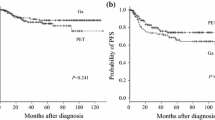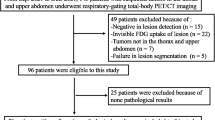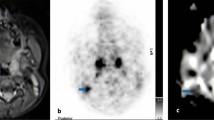Abstract
Coincidence-detection 18F-FDG-PET (PET) and 67Ga whole-body and SPECT (Ga) were compared in children and young adults with newly diagnosed Hodgkin’s disease (HD). Materials and methods: Thirty patients with histologically confirmed HD underwent PET with attenuation correction 1 h after injection of 150–220 MBq 18F-FDG and whole-body and SPECT imaging 72 h after injection of 250–370 MBq 67Ga citrate. Two experienced readers retrospectively reviewed PET and Ga scans, grading 13 anatomic regions from one (normal) to five (abnormal). Numerical stages were assigned based on Ann Arbor classification. Comparison was made with disease sites (established by biopsy or two or more of the following: physical examination, conventional imaging studies, radionuclide studies, and follow-up studies) and clinical stages. Sensitivity, specificity, and accuracy were calculated and significance of differences determined using McNemar’s test. Results: PET detected 120/138 (87%) disease sites and Ga 109/138 (79%). PET and Ga were concordant for 103/138 (75%) sites. Accuracies were not significantly different for supradiaphragmatic disease. PET was more accurate than Ga for detecting splenic (0.91 vs 0.61, P=0.012), infradiaphragmatic (0.89 vs 0.75, P=0.042), and all disease sites combined (0.95 vs 0.91, P=0.039). PET stage agreed with clinical stage in 79% of patients and Ga in 71%. Conclusion: PET was superior to Ga for evaluating children and young adults with newly diagnosed HD.




Similar content being viewed by others
References
Jemal A, Tiwari RC, Murray T, et al (2004) Cancer statistics 2004. CA Cancer J Clin 54:8–25
Bleyer A (2004) Older adolescents with cancer in North America: deficits in outcome and research. Pediatr Clin North Am 49:1027–1042
Kennedy BJ, Fremgen AM, Menck HR (2000) Hodgkin’s disease survival by stage and age. J Am Geriatr Soc 48:315–317
Lister TA, Crowther D, Sutcliffe SB, et al (1989) Report of a committee convened to discuss the evaluation and staging of patients with Hodgkin’s disease: Cotswolds meeting. J Clin Oncol 7:1630–1636
Rehm PK (2001) Radionuclide evaluation of patients with lymphoma. Radiol Clin North Am 39:957–978
Parkhurst JB, Foster P, Johnson SF, et al (1998) Upstaging of non-Hodgkin’s lymphoma in a child based on 67gallium scintigraphy. J Pediatr Hematol Oncol 20:174–176
Anderson KC, Leonard RC, Canellos GP, et al (1983) High-dose gallium imaging in lymphoma. Am J Med 75:327–331
Hoh CK, Glaspy J, Rosen P, et al (1997) Whole-body FDG-PET imaging for staging of Hodgkin’s disease and Lymphoma. J Nucl Med 38:343–348
Moog F, Bangerter M, Diederichs CG, et al (1997) Lymphoma: role of whole-body 2-deoxy-2-[F-18]fluoro-D-glucose (FDG) PET in nodal staging. Radiology 203:795–800
Kostakoglu L, Goldsmith SJ (2000) Fluorine-18 fluorodeoxyglucose positron emission tomography in the staging and follow-up of lymphoma: is it time to shift gears? Eur J Nucl Med 27:1564–1578
Willkomm P, Palmedo H, Grünwald F, et al (1998) Functional imaging of Hodgkin’s disease with FDG-PET and gallium-67. Nuklearmedizin 37:251–253
Wirth A, Seymour JF, Hicks RJ, et al (2002) Fluorine-18 fluorodeoxyglucose positron emission tomography, gallium-67 scintigraphy, and conventional staging for Hodgkin’s disease and non-Hodgkin’s lymphoma. Am J Med 112:262–268
Kostakoglu L, Goldsmith SJ (2000) Positron emission tomography in lymphoma: a comparison with computed tomography and gallium-67 single photon emission computed tomography. Clin Lymphoma 1:67–74
Shen YY, Kao A, Yen RF (2002) Comparison of 18F-fluoro-2-deoxy positron emission tomography and gallium-67 citrate scintigraphy for detecting malignant lymphoma. Oncol Rep 9:321–325
Bar-Shalom R, Yefremov N, Haim N, et al (2003) Camera-based FDG PET and 67Ga SPECT in evaluation of lymphoma: comparative study. Radiology 227:353–360
Kostakoglu L, Leonard JP, Kuji I, et al (2002) Comparison of fluorine-18 fluorodeoxyglucose positron emission tomography and Ga-67 scintigraphy. Cancer 94:879–888
Rini JN, Manalili EY, Hoffman MA, et al (2002) The utility of 18FDG and 67Ga for the detection of splenic involvement in Hodgkin’s disease. Clin Nucl Med 27:572–577
Rini JN, Leonidas JC, Tomas MB, et al (2003) FDG PET versus CT for evaluating the spleen during initial staging of lymphoma. J Nucl Med 44:1072–1074
Tatsumi M, Kitayama H, Sugahara H, et al (2001) Whole-body hybrid PET with 18F-FDG in the staging of non-Hodgkin’s lymphoma. J Nucl Med 42:601–608
Lackner K, Brecht G, Janson R, et al (1980) The value of computed tomography in the staging of primary lymph node neoplasms (in German). Fortschr Geb Roentgenstr Nuklearmed 132:21–30
Mendenhall NP, Cantor AB, Williams JL, et al (1993) With modern imaging techniques, is staging laparotomy necessary in pediatric Hodgkin’s disease? A pediatric oncology group study. J Clin Oncol 11:2218–2225
Carbone PP, Kaplan HS, Musshoff K, et al (1971) Report of the committee on Hodgkin’s disease staging classification. Cancer Res 31:1860–1861
Zweig MH, Campbell G (1993) Receiver operating characteristics (ROC) plots: a fundamental evaluation tool in clinical medicine. Clin Chem 39:561–577
Bartold SP, Donohoe KJ, Fletcher JW, et al (1997) Procedure guideline for gallium scintigraphy in the evaluation of malignant disease. J Nucl Med 38:990–994
Aygun B, Karakas SP, Leonidas J, et al (2004) Reliability of splenic index to assess splenic involvement in pediatric Hodgkin’s disease. J Pediatr Hematol Oncol 26:74–76
Strijk SP, Wagener DJ, Bogman MJ, et al (1985) The spleen in Hodgkin’s disease: diagnostic value of CT. Radiology 154:753–757
Hancock SL, Scidmore NS, Hopkins KL, et al (1993) Computed tomography assessment of splenic size as a predictor of splenic weight and disease involvement in laparotomy staged Hodgkin’s disease. Int J Radiat Oncol Biol Phys 28:93–99
Author information
Authors and Affiliations
Corresponding author
Rights and permissions
About this article
Cite this article
Rini, J.N., Núñez, R., Nichols, K. et al. Coincidence-detection FDG-PET versus gallium in children and young adults with newly diagnosed Hodgkin’s disease. Pediatr Radiol 35, 169–178 (2005). https://doi.org/10.1007/s00247-004-1325-2
Received:
Revised:
Accepted:
Published:
Issue Date:
DOI: https://doi.org/10.1007/s00247-004-1325-2




